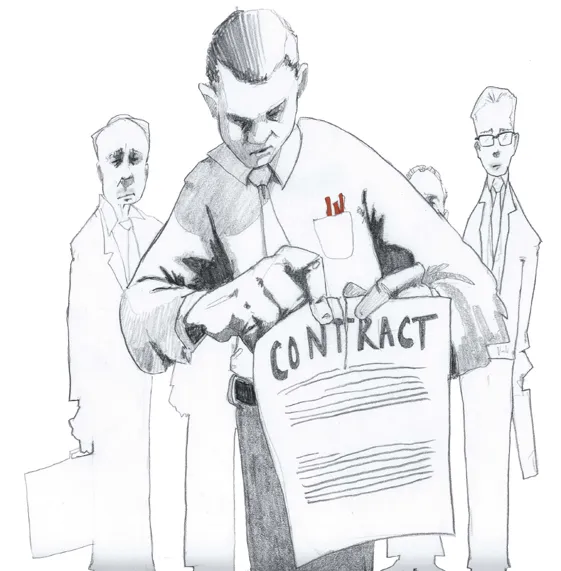Karl Marx had one. As did Simón Bolívar. Now you do too. Congratulations.
Be proud. Copy it onto vellum, and read it out loud from the wreckage of your overturned desk.
What’s a revolt without something to hold in your hands?
We feel marketers need a manifesto to change the thinking from a set of outdated ideas to another, more relevant set. There’s nothing better to establish the guiding principles by which like-minded revolutionaries can live.
The Punk Marketing Manifesto consists of fifteen articles, each of which should be followed without fail for the revolution to carry you along with it and not leave you trampled underfoot. So with no further ado:
The Articles of the Revolution
Article One: Avoid Risk and Die
In times of change the greatest risk is to take none at all.
Risk is one of those words that to some sound bad and to others good. It’s easy to ask others to take a risk but not so easy to take one yourself. (What’s that Joe Jackson line about giving advice but never taking any yourself?) But in this revolution—no, actually, in all revolutions—risk is a necessity for anyone who wishes to come out from behind the barricades as the winner.
The trick is to take calculated jumps and share them among all stakeholders with your own blend of saucy verve and gusto.
So what’s a calculated risk in these days of careful conglomeration? Not necessarily one checked out with consumers (if research were a prerequisite, would Sony ever have launched the Walkman or Ted Turner started CNN?—conventional wisdom says nah) but one that has properly been thought through and discussed with those people involved with actually creating the thing. This is where sharing among the risk-taking stakeholders group is most needed.
Article Two: Why Not Ask “Why Not?”
Assumptions are just that. They are in no way true. Anything you assume is usually a half-truth or a generalization that once served a useful purpose but now hinders truly creative solutions.
One of the most innovative pieces of thinking in marketing in recent years was for Dove and its strangely titled Campaign for Real Beauty. Dove’s dad, Unilever, took the fundamental rule of the beauty-products category—that women featured in marketing must be stick-model perfect to be effective role models—and asked why not try something made for controversy: use models that are unconventionally good-looking, even curvy? The result was a campaign that made women everywhere feel special about not conforming to conventional views of perfection.
Article Three: Take a Strong Stand
Trying to be all things to everyone inevitably results in meaning little to anybody.
Why did John Kerry lose that election? Many reasons, but more than anything we’ll call it the way his rival strategists at the GOP played on the fear of the voters to keep a firm course of don’t-screw-with-us action. But many observers said a significant reason for his death at the polls was Kerry’s desire to be liked by everyone and his habit of flopping from one viewpoint to another with each situation that popped up in his hyperactive sight line. One minute he’s talking about green issues until he’s blue in the face, the next he’s defending his family’s ownership of gas-eating SUVs (“Gee whiz, it’s my wife’s”).
Deciding what you want your brand to stand for must come from a firm set of well-thought-out beliefs you are prepared to defend on any battleground. So what if not everyone likes you? Most people don’t like you anyway—they certainly don’t dig us. Make those who do your loyal friends forever, and if you still need to be loved by newcomers, go out and start a new brand with equally strong but different positioning for those other wannabe lovers. Procter and Gamble lives by that credo and it works for them.
Article Four: Don’t Pander
Customers are important but they are not necessarily right.
The really good news about being resolute is that people respect you for it even if they don’t admit it. Respect from those who buy things is tough to get. Let us tell you a little secret: consumers like to be told what to do. They’re actually slightly submissive and want a brand to take charge, push them into a corner, stand proud, thump its chest and say, “This is me and this is what I’ve got to offer.”
What they don’t like is being asked what they want—because they don’t know! Henry Ford said it many years ago and it still holds true: “If I had asked my customers what they wanted, they’d have told me, ‘a faster horse.’” (One of us owned that horse in the form of a Fiesta.)
Of course people like to be given choices, but that’s different from coming off as being desperate to please everyone. Like, what’s with these incessant price promotions, incentives, and cash-back offers that are all the rage with U.S. automakers? Distress marketing makes consumers think there’s something wrong, pure and simple. Avoid it and folks will respect you again.
Article Five: Give Up Control
Consumers now control brands—end of debate. Smart marketers recognize this and embrace it rather than fight the powerful truth.
A long time ago (the nineties), there was a one-way process by which marketers and those providing content delivered their product to consumers. Consumers sat in front of their TVs or radios and were entertained. The marketing messages were a necessary evil, to fund what they enjoyed.
Then when the faceless TiVo machine and its offspring came along, viewers had a way to opt out of commercials altogether. At the same time the rise of alternative forms of content and ways of getting it let consumers become participants rather than recipients, forcing more of a two-way conversation with the marketers and media moguls.
The once unspoken contract between providers and consumers has expired, and a new version has been written by the latter. No more cheap entertainment in exchange for their attention to what we sell! Thus any marketer needs to make its message as enjoyable as the content it funds and consumers will choose rather than just endure it—or click off.
Article Six: Expose Yourself
A relationship of trust between brand and consumer, like that between two people, is built upon honesty.
How strange that honesty has become such a rare commodity in relationships between commerce and consumers! We live in a bargain-hunting culture that has encouraged marketers to become hucksters and talk incessantly about the deal: how much money can be saved from a product or service that is the most unbelievable…thing…ever. Unbelievable because, well, it’s not really true. It’s hype! Truth has become a powerful filter, and brands that don’t pass muster are quickly disregarded for ones that pass it.
Prior to the mass immediate sharing of what-we-know that the Internet gave us, this was hardly a big deal; if the lowly buyer felt the product didn’t live up to its hype, he or she might complain to the seller or maker. Today, via instant feedback on sites like Shopping.com and Buy.com, plus consumer opinions basically everywhere via blogs et al., you can instantly outweigh the impact of any carefully crafted marketing campaign by just shouting about how It stinks (e.g., PunkStinks.com).
The success of eBay is due to trust created between buyers and sellers through those damning or glorifying user-feedback ratings. Why would you pay money to perfect strangers if you saw they were imperfect?
Honesty, once a way to stand out, is now the point of entry! You, the smart revolutionary marketer, can earn the trust of cynical consumers and show you are open to feedback from them. As semiretired billionaire Bill Gates once muttered, “Your most unhappy customers are your greatest source of learning.”
Amen, Billy.
Article Seven: Make Enemies
All brands need to position themselves against an alternative.
It may seem counterintuitive but having an enemy is a good thing for a brand.
One British workaholic, Richard Branson, is a master beyond comprehension at positioning his Virgin brands against the market leader in whatever category he dives into; so those competitors become his archenemy without fail. And what do you do to enemies? Fight them off with big sticks! When Sir Richard launched Virgin Cola in the United States, he took a full-page ad in the New York Times to challenge Coca-Cola’s CEO to an arm-wresting match (loser quits the U.S. market, ha!). Then he, Mussolini-like, drove a tank down Manhattan’s Fifth Avenue to seek him out—cameras trailing him everywhere. Talk about serious cojones going against his enemies in this manner. We like.
Oh, and need we tell you? Sometimes the enemy need not be so obvious. For the antismoking campaign created by ad agency emeritus Crispin Porter + Bogusky for the busy State of Florida, the chosen foe was not the health risks of smoking—since a teen target audience already knew these and assumed the risks were greater than they actually were—but evil fibs spread by Big Tobacco. (See chapter 9 for more on the “Truth” campaign.)
Article Eight: Leave Them Wanting More
Avoid the temptation to reveal all of your assets at once. Or as the masters have said, you don’t teach them everything you know. You teach them everything they know.
The temptation is for marketers to shout out all the brand’s strengths rather than let consumers discover them over time. This always forsakes one of the most powerful marketing tools, the one we used back in high school to get sex: we’re talking about the tease!
Reveal bits and pieces about who you are over time and leave some to the imagination. Ah, yes—mystery. Then you have a buyer who’s “in” and will subsequently need to seek out more. Think of the skillful stripper slowly showing more of her assets and leaving an audience panting.
Putting salaciousness aside, just look: a brand has the same power to draw people in so that consumers want to pull and don’t need anyone to push.
A big bad beast of a brand, Nike has learned to hold back to increase sexy appeal. The Air Force 1 sneaker is one of its biggest sellers, and still Nike manages supply carefully by keeping it real tight and releasing collectible versions just as Disney does with Bambi.
Article Nine: Outthink the Competition
Think smarter than the other dude.
Do not be led into temptation by the fast buck, Freddie; and don’t outspend them. That is the definition of fool’s gold.
A friend described advertising as the one remaining legal way to beat the crap out of your competition. Marketing executed by the best will always beat the pants off the lesser equivalent, no matter how gargantuan the opponent’s budget.
Having a huge budget to play with merely tempts marketers to do two things they shouldn’t: take only tried and tested (and, truthfully, dull) approaches; and treat consumers as ...


